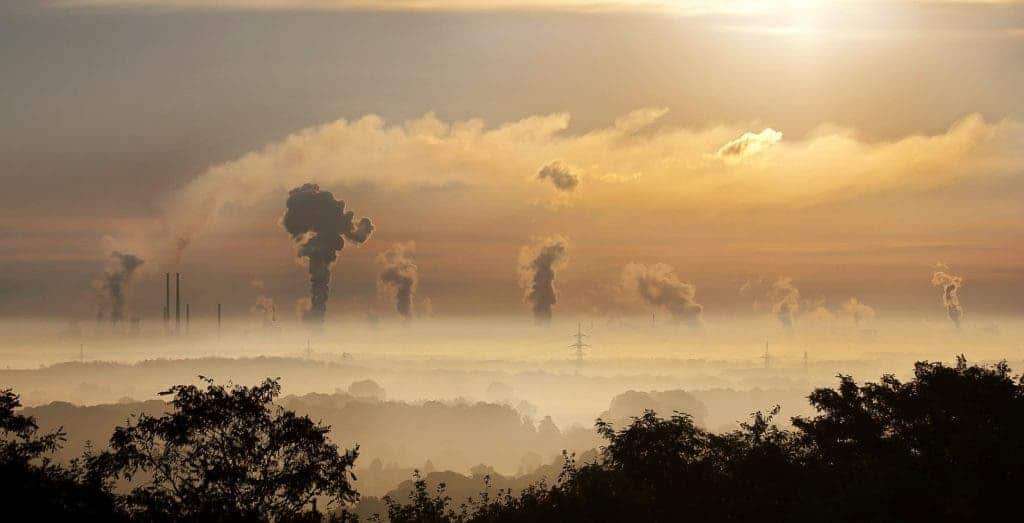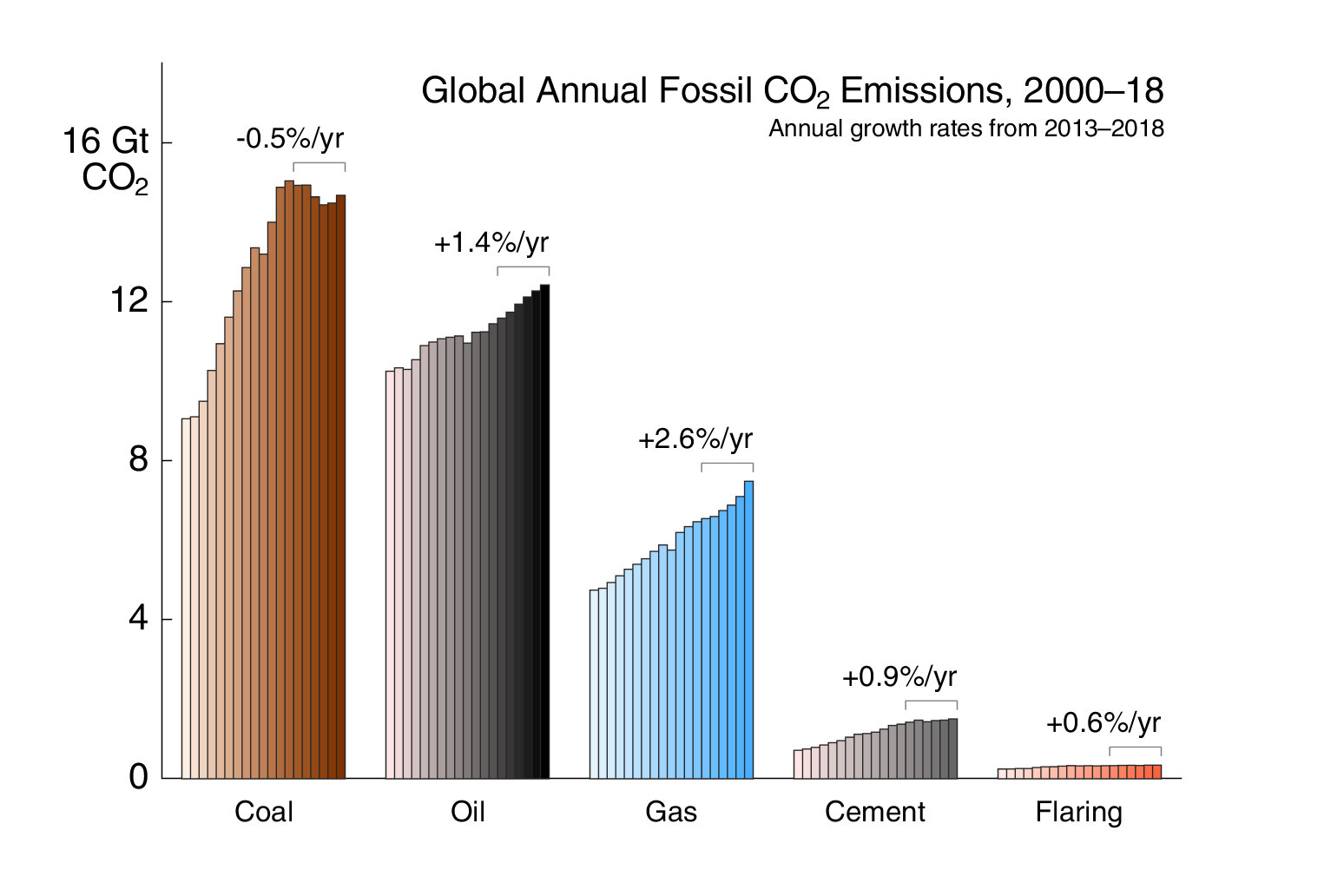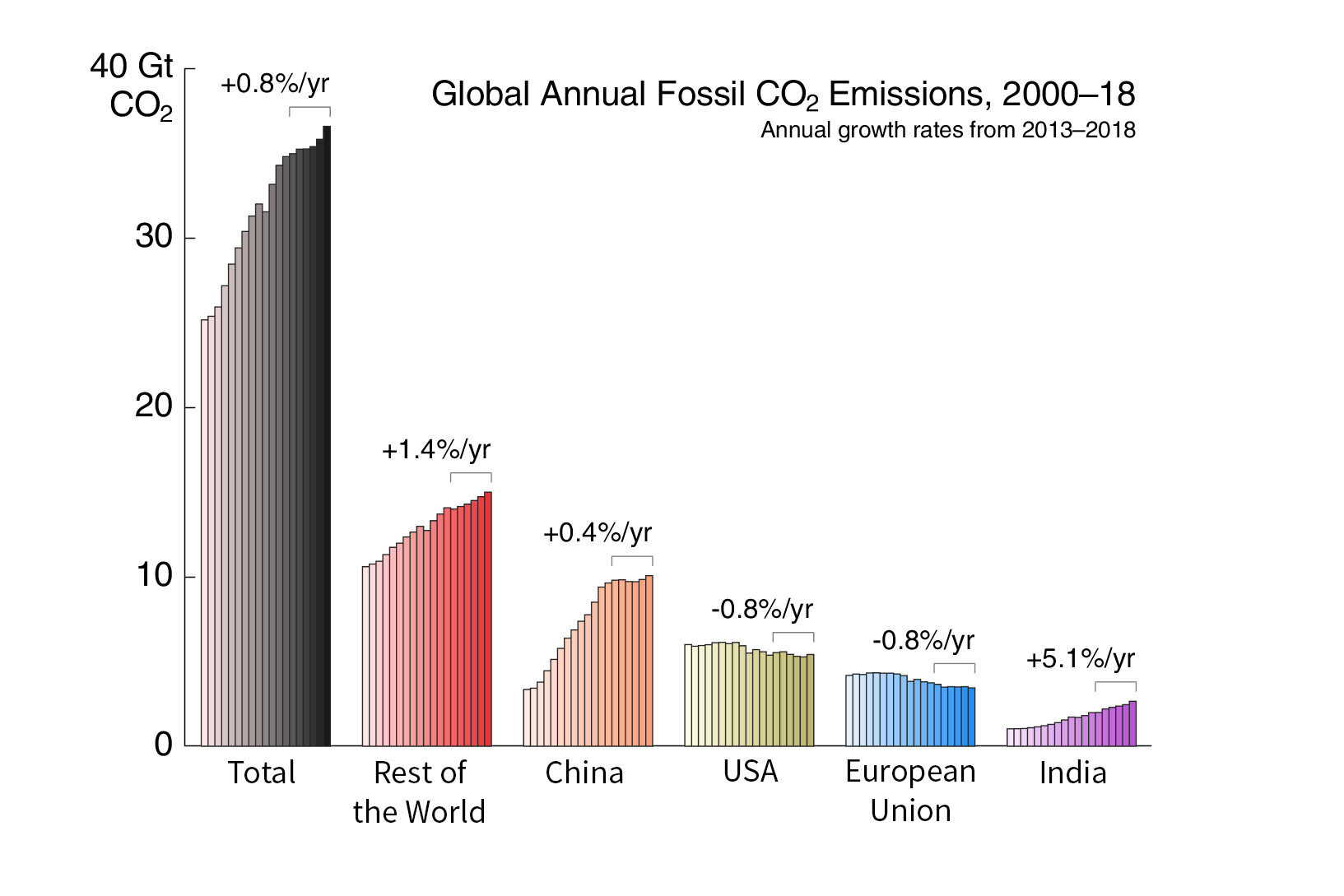The rate of carbon emission growth in 2019 has dropped compared to those of 2018 and 2017. However, overall CO2 emission levels are expected to reach 37 billion tons — a record high.

Image via Pixabay.
The estimates come from the Global Carbon Project, an initiative led by Stanford University scientist Rob Jackson, and have been published in advance of the 25th conference of the United Nations Framework Convention on Climate Change in Madrid. Overall, emission levels in 2019 are projected to rise by 0.6% over 2018 levels, compared to a 2.1% and 1.5% rise in 2018 and 2017, respectively.
The authors warn that while the rise in emissions is slowing down, emission rates are very likely to keep increasing through to 2030 unless world leaders take meaningful action to reduce fossil fuel use in national energy, transportation, and industry sectors.
Good, not good enough
“When the good news is that emissions growth is slower than last year, we need help,” said Jackson, a professor of Earth system science at the Stanford School of Earth, Energy & Environmental Sciences.
“When will emissions start to drop?”
On the one hand, we see reasons for hope: coal use is in decline across most developed, western states (such as the EU and US). On the other hand, reductions here are canceled out by increased use of oil and natural gas around the world. Fossil fuel use accounted for roughly 90% of all emissions from human activities in 2018, according to Carbon Brief.

Image credits Jackson et al., 2019, Environmental Research Letters.
Rich, developed countries also release a disproportionately high level of emissions per capita, although they are in the best position to switch to alternative energy sources. This is particularly worrying and likely to throw a wrench in climate negotiations, the team explains, as developing countries are (understandably) keen on using fossil fuels to strengthen their economies and provide better lives for their citizens — which, in essence, is exactly what developed countries have done in the past.
“Because per capita oil consumption in the US and Europe remains 5- to 20-fold higher than in China and India, increasing vehicle ownership and air travel in Asia are poised to increase global CO2 emissions from oil over the next decade or more,” notes one of three papers detailing the findings, published in Environmental Research Letters.
About 40% of fossil-fuel-related carbon dioxide emissions were attributable to coal use, 34% from oil, 20% from natural gas, and the remaining 6% from cement production and other sources, they report. The US, EU, and China together account for over half of all carbon emissions globally. Some success has been registered in the US and EU, whose emissions are projected to drop by 1.7% compared to 2018. However, this is more than offset by increases in other countries. China, for example, is projected to emit 2.6% more carbon in 2019 than it did in 2018 — and it’s far from the only place to see such a trend.
Changes in the energy grid mosaic
“Emissions cuts in wealthier nations must outpace increases in poorer countries where access to energy is still needed,” said Pierre Friedlingstein, a mathematics professor at the University of Exeter and lead author of the Environmental Research Letters study.
So where is all this carbon coming from? The good news is, it’s not from coal. This old-timer of a fossil fuel has seen a 0.9% drop in use, worldwide, compared to 2018. Its fading popularity — displaced by cheaper natural gas, wind, and solar power — can explain much of the drop in emissions seen by the US: coal use dropped 11% here compared to last year. The EU has reduced its coal use by around 10%. China, the single largest coal consumer in the world (making up around half the global demand for coal), has registered an increase of only 0.8% in coal use this year, largely due to an economic downturn.
At the same time, natural gas use has risen sharply. While it does indeed result in fewer emissions than coal or oil, its greater availability and the lower price have encouraged consumption so, overall, we’ve seen 2.6% more use and 2.5% more emissions (to 7.7 billion tons) from natural gas compared to 2018. The team singles out natural gas as a leading cause of carbon emission growth in recent years, accounting for around 60% of the total increase.
“Liquified natural gas exports from Australia and the United States are surging, lowering natural gas prices in Asia and increasing global access to this fossil resource,” Friedlingstein’s team adds.
“The global LNG trade grew 10% in 2018 to 317 million tonnes, the fifth consecutive year of record trade. [….] Greater natural gas supply coupled with cheaper prices could extend the market penetration of natural gas for decades.”
However, natural gas has been marketed as a “bridge fuel” — a stop-gap measure to help countries wean off of fossil fuels. The team says this hope is somewhat grounded in reality, but only if policymakers take concrete action to help make it so. Measures in support of carbon capture and storage (to mediate CO2 emissions) and a reduction in methane leakage from natural gas infrastructure are vital for this goal.
Some are more equal than the others

Image credits Jackson et al., 2019, Environmental Research Letters.
And now for the contentious part: per capita emission inequality. The average human today is responsible for around 4.8 tons of fossil carbon dioxide emissions per year. The average US citizen, in contrast, emits three to three-and-a-half times as much. Developing countries are catching up, both in the standard of living and emission levels — per capita emissions in China now rival or even exceed those in the EU, for example. The Global Carbon Project explains that oil consumption per capita in the US is 16 times greater than in India, and 6 times greater than in China. In the US, there’s almost one car on the road for every citizen — there’s one for every 6 people in China, and one for every 40 people in India.
This leaves calls to reduce fossil fuel open to critique for a holier-than-thou attitude. If wealthy nations got where they are by burning and polluting, why should developing countries ‘pay the bill’?
Do I think this is a healthy attitude? No, I think it leaves us all worse off and will come around to bite us, all of us, in the back. But I do see the point. National governments, first and foremost, have to answer to their citizens. In their view, people in other countries made this mess and got rich off of it, and those people are now are asking everybody else to give up the same wellbeing to clean it up — without compensation. It’s a very raw deal if you ignore the whole ‘climate emergency’ bit.
What to do about it
Not all is lost, however. Previous research has found that 18 or so countries have managed to both expand their economies and reduce emissions over the last decade, most notably the United Kingdom and Denmark, showing that countries (especially rich ones) can switch to clean energy without sacrificing prosperity. Key to their success was a reduction in energy use overall while new renewable fuel capacity was being installed to displace fossil fuels.
The team writes that stronger commitments and policy, both at a national and global level, can help us out of this bind. They list carbon pricing, improvements in the energy sector, reductions in energy use, the use of electric vehicles, as well as carbon capture and storage as some areas to focus on in the future. Of course, there’s also the straightforward way: doing our absolute best in phasing out fossil fuels for clean energy.
“We need every arrow in our climate quiver,” Jackson said. “That means stricter fuel efficiency standards, stronger policy incentives for renewables, even dietary changes and carbon capture and storage technologies.”
The three papers describing the findings are:
“Persistent fossil fuel growth threatens the Paris Agreement and planetary health”, published in the journal Environmental Research Letters.
“Global Carbon Budget 2019”, published in the journal Earth System Science Data.
“Carbon dioxide emissions continue to grow amidst slowly emerging climate policies”, published in the journal Nature Climate Change.


